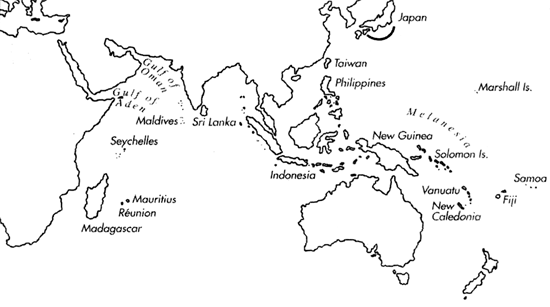Range: Hyotanse Bank, Izu-Shichito Is., off Honshu, Japan.
Description: Small. Last whorl ventricosely conical; outline convex adapically, less so (right side) or concave (left side) below. Shoulder rounded to indistinct. Spire high, outline slightly sigmoid. Larval shell of 2 whorls. First postnuclear whorl weakly tuberculate. Telcoconch sutural ramps slightly convex, with 3 increasing to 5 spiral grooves. Last whorl with fine closely spaced spiral ribs.
| Shell Morphometry | ||
|---|---|---|
| L | 17-22 mm | |
| RW | - g/mm | |
| RD | 0.55-0.58 | |
| PMD | 0.77-0.80 | |
| RSH | 0.25-0.28 | |
Ground colour cream. Last whorl with brown axial flames forming 3 variably continuous spiral bands, below shoulder and on both sides of centre. Adapical and central ground-colour band with 1-2 spiral rows of brown spots. Larval whorls and adjacent teleoconch sutural ramp white. Following sutural ramps with brown radial streaks and blotches, covering nearly the entire ramp in late whorls. Aperture white.
Periostracum thin (Okutani, 1972).
Habitat and Habits: In about 200 m (Okutani, 1972).
Discussion: C. scopulicola is only provisionally considered a valid species, as it may represent the subadult stage of a larger member of the species-group represented by C. smirna. C. lani differs in its narrower, more conical last whorl (RD 0.50-0.55; PMD 0.84-0.89) with straight outline, and in its more uniform colouration. C. smirna has a less ventricose last whorl and its spire has more tuberculate whorls (5-6). C. profundorum has more tuberculate spire whorls (4-7), 3 or more larval whorls, a generally more distinct shoulder and a spirally orientated last whorl pattern with only one adapical colour band. C. ikedai can be distinguished by its generally narrower and less ventricose last whorl (RD 0.53-0.56; PMD 0.81- 0.84), lower spire (RSH 0.16-0.21), greater number of tuberculate spire whorls (3), more distinct shoulder, and by the absence of a brown pattern. For comparison with C. darkini and C. jeanmartini see the Discussions of those species. The closest resemblance in colour pattern is shown by those specimens from New Caledonia and the New Zealand area that we have tentatively assigned to C. smirna (see the Discussion of C. smirna).

C. scopulicola range map
This section contains verbatim reproductions of the accounts of 316 species of Conus from the Indo-Pacific region, from Manual of the Living Conidae, by Röckel, Korn and Kohn (1995). They are reproduced with the kind permission of the present publisher, Conchbooks.
All plates and figures referred to in the text are also in Röckel, Korn & Kohn, 1995. Manual of the Living Conidae Vol. 1: Indo-Pacific Region.
The range maps have been modified so that each species account has it own map, rather than one map that showed the ranges of several species in the original work. This was necessary because each species account is on a separate page on the website and not confined to the order of accounts in the book.